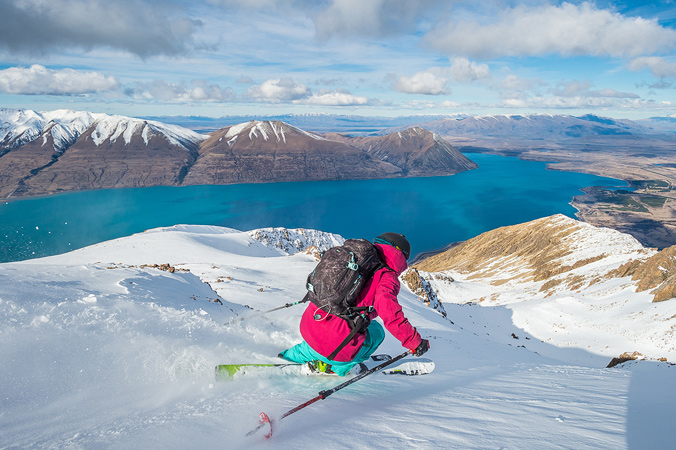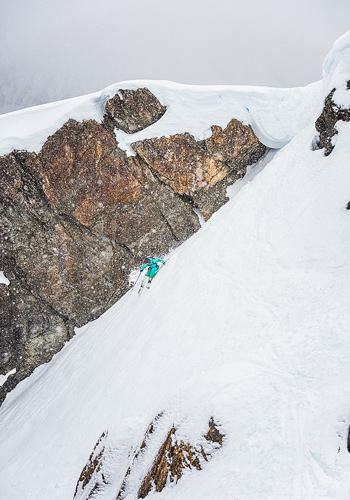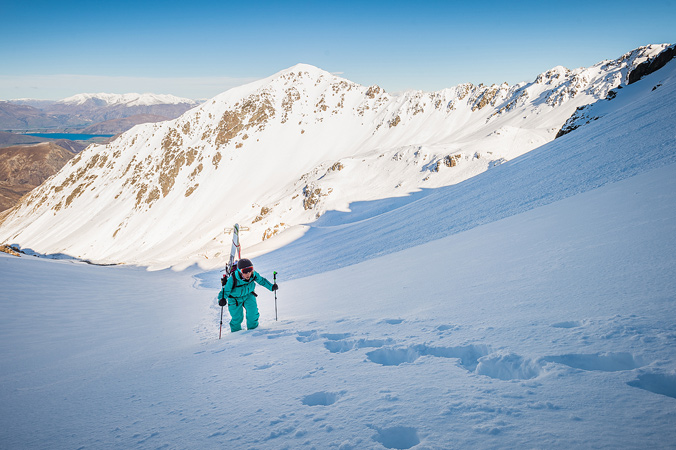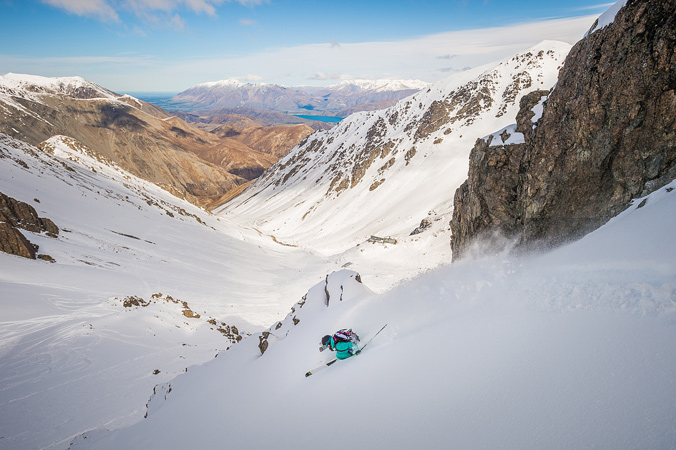Freeskier Nat Segal of Melbourne, Australia is no stranger to the inconsistent winters that her home island and its southern neighbor, New Zealand experience. But her passion for adventure is constant motivation for her exploration of the southern Pacific’s wild mountains. In search of that perfect weather window when new snow and cool temps line up for a perfect powder day, she set out in the Southern Hemisphere’s winter 2016—flying from Melbourne to Christchurch—to see what the south island had in store. Here, she writes about her journey. —Louise Lintilhac
New Zealand is a place of extremes, from the yellow, dusty, dry tussock found around lake regions of the Southern Alps to the blues and whites of the northern mountains. The only constant in the mountains is seemingly inconsistency—of the snow and the forecast.
Being a small landmass just north of Antarctica, the weather changes quickly and storms can hit without much warning and fizzle out as quickly as they are spotted. Fickle conditions can make planning difficult, and that’s why, last winter, when I decided to organize a trip to the Southern Alps, I did my best to expect the unexpected.

Nat Segal overlooks blue water in Ohau. [Photo] Mark Bridgwater
The Southern Alps are perfect for this kind of adventure. Due to minimal infrastructure there are really only three ways to get into the backcountry: hitch a ride on a club fields lift, hire a helicopter or slog through tundra, bushes and streams.
But while our plans were coming together, the winter was not. Minimal snowfalls meant that the likelihood of finding good ski conditions became much less likely. With no budget for helicopters, we settled for exploring some lift-accessed backcountry between the towns of Tekapo and Christchurch.
Before my departure, I incessantly checked the forecast waiting for a good stretch of weather. Finally in mid-August, the conditions looked like they were improving and I booked a last minute flight to Christchurch from my home in Melbourne.
Not quite sure what I would be facing, I packed light, bringing along one set of skis, a few extra layers and some back-up snacks. Before I boarded my flight, Mark and I made a loose plan to meet at Ohau Snow Fields in New Zealand’s Southern Alps.
Touching down in Christchurch, the conditions had improved, but snow cover was still a bit thin. Luckily, even without stellar snow, Ohau always has something to offer a keen skier and if all else fails, it has one of the best mountainside views in New Zealand.
Tucked away on a dirt road somewhere between Christchurch and Wanaka, Ohau sports a relaxed vibe, both on and off the hill, and the only thing better than the breakfast served at the lakeside lodge is the bc-skiing accessibility off Mount Sutton—a 10-minute bootpack above Ohau’s lone two-seater chair.
We spent two days skiing and hiking up the ridgeline of Mount Sutton. We found cold snow protected from the sun on the south faces, followed by spring snow all the way down to the access road. While some of the runs were on the shorter side, lift-access allowed us to do several laps a day and still find untracked snow.
Our open schedule allowed us to chase storms, so we turned north to the Southern Alps’ Canterbury club field when we learned the region was about to be hit by an incoming storm.
Infamous among foreigners and loved by locals, the Canterbury ‘clubbies’ are community-built ski areas, maintained by their associated clubs. Ski runs are accessed by rope tows and sleeping quarters are shared along with the daily lodge chores. They have a low-key, community vibe and host some of the best backcountry access in the region.
When we arrived, we didn’t find the powder snow we had been praying for, but we headed out despite conditions that Temple Basin ski area manager Forrest Bilek called a mix between snow and rain, “depending on where you are standing.”

Segal explores Temple Basin’s steeps. [Photo] Mark Bridgwater
The next morning we woke up early and convinced the staff to hike to the summit of Mount Temple to watch the sun rise before the next storm rolled in. Our headlamps strobed against the dark walls of the couloir as we bootpacked upward. As the sky began to lighten, we crested Mount Temple’s ridgeline. My expectations were dashed; we were met with flat, grey light. Everything but the weather wanted us to succeed.
Undeterred, we struck out to our final destination seven hours away in New Zealand’s northern mountains—Mt. Olympus, also know as the “Playground of the Gods,” where a promise of snow kept our hopes alive. Fat flakes covered the windshield as we drove up the sketchy access road to Mt. Olympus.

Segal ascends Mt. Olympus. [Photo] Mark Bridgwater
But the following day cracked blue—a cool evening had settled the snow and after being given the OK by ski patrol, Mark and I started hiking toward The Sphinx, a backcountry area one ridgeline over from the main slopes at Mt. Olympus.
We were alone when we topped out on the ridge, and after spending the weekend at Mt. Olympus, I finally got to see the region’s full potential.

Segal arcs down Mt. Olympus. [Photo] Mark Bridgwater
It was less than I had hoped for but more than I had expected. Like so many trips to New Zealand, I wasn’t quite satiated and was already planning my next trip, but I know that you have to be patient in New Zealand to get the goods.
—
To see more of Mark Bridgwater’s photography, visit markbridgwater.co.nz.










Related posts: